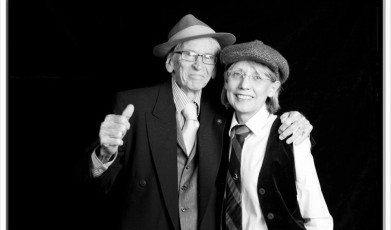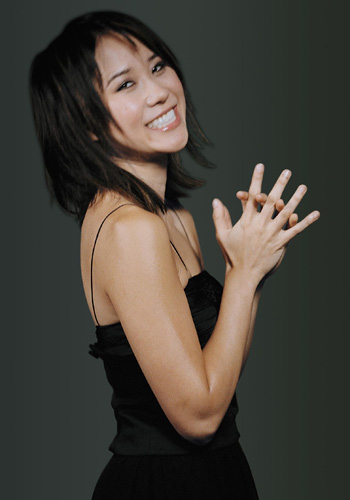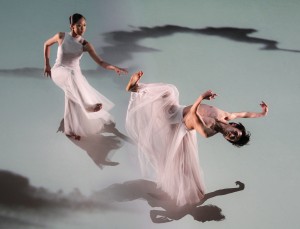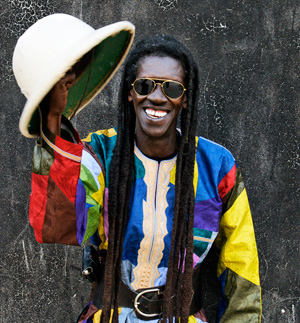Student Spotlight: Greg Hicks on How Max Raabe’s Tailored Tuxes Will Open Your Mind
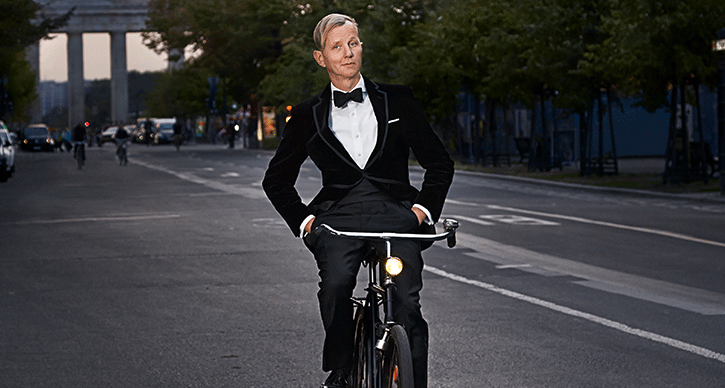
Photo: Max Raabe rides his bicycle. He performs with his Palast Orchester on April 9, 2015 at Hill Auditorium. Photo by Marcus Hoehn.
Max Raabe and Palast Orchester are a well-groomed lot, both musically and visually — trained at the Berlin University of the Arts, tux-friendly, hair parted to one side — and that very sense of aesthetic perfection is what makes Raabe and company so unpredictable. While every tux is tailored to perfection and every stray hair is combed into place, Raabe’s creative persona throws the experience of the performance off-kilter in the best way.
The Raabe method of approach is to give a taste of vintage formality to a situation that might not require it. Past examples from Raabe include (but are not limited to):
- Using a condenser microphone to sing a live cover of Britney Spears’s “Oops…I Did It Again.”
- Wearing a tux while singing a cover of Queen’s “We Will Rock You.”
- Singing the 1930s hit “Dream a Little Dream” at music festivals.
Take a walk through Max Raabe and Palast Orchester’s photo gallery and you’ll get the same impression. You’re greeted with a photo of Raabe riding a bike — no-handed — through a city road whilst wearing his classic tuxedo, giving a casual grin to the photographer.
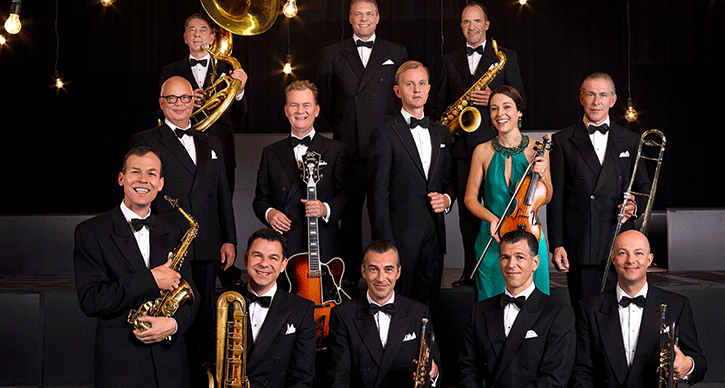
The Palast Orchester. Photo by Marcus Hoehn.
As you continue your photo exploration, you’ll find Raabe and the eleven other members of the Palast Orchester crammed into a paddleboat, instruments in hand, dressed in tuxes, casually floating along the lake. In further shots, Raabe is photographed mostly-submerged in the lake, head popping out, staring directly into the camera — still dressed in his tux. Oh, and there’s also a duck floating past him.
Why the constant throw-back attire, Mr. Raabe?
For one thing, cherry picking visual styles all the way back to the 1920s establishes an image to “not look the type” to perform contemporary music brands — allowing Raabe to shock and surprise audiences with well-orchestrated versions of relatively modern radio hits like “Oops…I Did It Again” and “We Will Rock You.” And Raabe isn’t the only notable artist to visually belong to one era of music while successfully surprising listeners with renditions of another.
Last year, pop sensation Lady Gaga showcased a similar visual deception — though in her case, pop aesthetic combined with jazz standards. Unlike Raabe, Gaga often exemplifies the most contemporary, dynamic image in her style, and on her latest record Cheek to Cheek, Gaga melded this persona into a record consisting of classic jazz hits sung with jazz icon Tony Bennett.
World-wide pop-rock sensation Robbie Williams (who often displays a “bad boy” stylistic persona) used a similar technique on his unexpected 2001 jazz standard cover album Swing When You’re Winning and again in 2013 with Swings Both Ways.
Pop diva Christina Aguilera went so far as to release an album of entirely original tracks in throwback production style on Back to Basics. Aguilera, Williams, and Gaga were all heavily praised for their surprising capabilities to sing in these unexpected genres.
And here on the flip side, we have Max Raabe, who takes a vintage image and displays his capabilities in the realm of popular music.
The visual foundation of the German old-style group is something that, upfront, audiences might take very seriously, given the formal vintage look. But upon observing the group’s surprising photoshoots and song cover choices, a new open-mindedness with a taste for the abstract and a quirky sense of humor might unfold.
When Max Raabe and the Palast Orchester performed previously in Ann Arbor, UMS gave fans the opportunity to sample their own vintage attire in an in-venue photo booth, and the same is encouraged this year. Come dressed in your best 1920s fashions, but don’t forget to bring your sense of humor as well!
Max Raabe and Palast Orchester perform at Hill Auditorium on April 9, 2015.
Interested in more? Explore even more audience photo booth photos from Max Raabe’s last appearance in Ann Arbor.
From our photo booth at Max Raabe and the Palast Orchester
More photo booth here.
Welcome to the Cabaret
With UMS offices on Liberty Street, lab cafe has become a favorite go-to spot for our caffeinated indulgences. (Seriously, a fair amount of our emails, program books, and community engagement activities are fueled by that coffee!) Tobias Wacker, owner of lab, has been talking to us about Max Raabe ever since we announced the 11/12 season. Toby’s enthusiasm is so infectious that we felt it would be a true disservice to keep it to ourselves. So here it is, in his own words for your reading enjoyment.
Growing up in Villingen-Schwenningen, my German parents loved Max Raabe. Parties were not really parties without some Max and his Palast Orchester. Things got even better once we had a VCR and were able to watch his performances on TV. Frankly, the whole thing seemed rather strange to me at the time. Why are we listing to old timey tunes with silly lyrics like “my little green cactus is sitting outside on the balcony?” Why are they performing inside a circus tent? Long before the 1920s became the decade of choice for hip kids, Max Raabe transported you back to roaring pre-war Berlin, a city saturated with cabaret and absinth where the good times never seemed to stop. His infectious mix of classics, original material, and pop music covers achieves the rare state of making music for our era while preserving the authenticity of its vintage roots. And the grown-up me can’t wait to see it live for the first time. Welcome to the cabaret – it’s going to be a wild night!
Max Raabe shows off his cabaret glam in his rendition of Beir Mir Bist du Schoen.
Max Raabe’s latest single, One Cannot Kiss Alone. (Click image to watch.)
Looking for more Max Raabe fun-facts? Check out this article by Franziska Schwarz for the Goethe Institute.
— Growing up in Germany and Los Angeles, Tobias Wacker is obsessed with making cities more livable through small shops and culture. He deeply believes in the power of innovation and just started getdapp.com, a website dedicated to modern goods made using traditional techniques and materials.
11/12 Asia & World Series
Asia
UMS focuses its global programming on four different regions of the world — the Arab World, Africa, the Americas, and Asia — with one region enjoying a particular focus during each season. Following the celebration of the performing arts of the Americas in the 10/11 season, UMS turns its thematic focus to Asia, specifically highlighting artists from China, Taiwan, Inner Mongolia, and India.
Subscription packages go on sale to the general public on Monday, May 9, and will be available through Friday, September 17. Current subscribers will receive renewal packets in early May and may renew their series upon receipt of the packet. Tickets to individual events will go on sale to the general public on Monday, August 22 (via www.ums.org) and Wednesday, August 24 (in person and by phone). Not sure if you’re on our mailing list? Click here to update your mailing address to be sure you’ll receive a brochure.
Yuja Wang, piano
Sunday, October 9, 4pm
Hill Auditorium
Twenty-four-year-old Chinese pianist Yuja Wang is widely recognized for playing that combines the spontaneity and fearless imagination of youth with the discipline and precision of a mature artist. She made her UMS debut in January 2008, just months after graduating from the Curtis Institute of Music, and since then has spent each year criss-crossing the globe with a cavalcade of impressive debuts and awards, including the prestigious Avery Fisher Career Grant, given to select musicians destined for bright solo careers.
Program
Ravel | Miroirs
Copland | Piano Variations
Rachmaninoff | Selected Preludes
Brahms | Sonata No. 1 or No. 3
Water Stains on the Wall
Cloud Gate Dance Theatre
Lin Hwai-min, artistic director
Friday, October 21, 8pm
Saturday, October 22, 8pm
Power Center
Trained in tai chi, meditation, Chinese opera movement, modern dance, and ballet, Cloud Gate Dance Theatre performs a rich repertoire with roots in Asian myths, folklore, and aesthetics, all infused with a contemporary perspective. For this long-awaited UMS debut, Cloud Gate presents Hwai-min’s newest work, Water Stains on the Wall. “Water stains on the wall” is a popular metaphor that represents the highest state in the aesthetics of Chinese calligraphy. Hwai-min and dancers take off from this metaphor and create and abstract work of beauty and magic that stands sublimely on its own.
AnDa Union from Inner Mongolia
Wednesday, November 9, 7:30pm
Michigan Theater
Formed in 2003, AnDa Union’s 14 members all hail from the Xilingol Grassland area of Inner Mongolia, a semi-autonomous region of China. AnDa Union are part of a musical movement that is finding inspiration in old and forgotten folk music from the nomadic herdsman cultures of Inner and Outer Mongolia, drawing on a repertoire of music that has all but disappeared during China’s recent tumultuous past. Its members are accomplished singers and instrumentalists, performing on the traditional horse-head fiddle (tsuur), the maodun chaoer, a three-holed flute, as well as Mongolian versions of the dulcimer, zither, lute, and mouth harp.
Beijing Guitar Duo with Manuel Barrueco
Sunday, November 20, 4 pm
Rackham Auditorium
Meng Su and Yameng Wang are widely noted for their outstanding technique and artistic musicality. They first met at the Central Conservatory in Beijing, where they began studying with the acclaimed professor Chen Zhi as children. Both women have won the Tokyo International Guitar Competition (Yameng Wang won it at age 12), and have received heaps of acclaim and recognition at international guitar events and from other seasoned guitarists, including Sergio Assad who has written and dedicated works to them. In 2008, they went to study with Manuel Barrueco at the Peabody Conservatory of Music in Baltimore and officially established themselves as the Beijing Guitar Duo. Both individually and together, their impressive talents come together to create one of the most excited guitar duos on the scene today.
Chamber Ensemble of the Shanghai Chinese Orchestra
Friday, February 10, 8pm
Rackham Auditorium
The 20 members of the Shanghai Traditional Chamber Ensemble are drawn from the first large-scale modern orchestra of traditional instruments in China. While Chinese stars such as Lang Lang have brought new attention to Western classical music in China, this ensemble provides a window into the traditional Chinese classical music that dates back centuries.
Zakir Hussain and the Master Musicians of India
Fazel Qureshi, tabla and kanjira
Rakesh Chaurasia, bansuri
Dilshad Khan, sarangi
Navin Sharma, dholak
Abbos Kosimov, doyra
Meitei Pung Cholom Performing Troupe (Dancing Drummers of Manipur)
Thursday, April 12, 7:30pm
Hill Auditorium
Zakir Hussain is today appreciated both in the field of percussion and in the music world at large as an international phenomenon. A classical tabla virtuoso of the highest order, his consistently brilliant and exciting performances have not only established him as a national treasure in his own country, but have earned him worldwide fame. For this return appearance, he performs with a host of Indian classical music greats, as well as the dancing drummers of Manipur.
Other World Music
In addition to the events from Asia listed above, UMS presents Goran Bregovic and His Wedding and Funeral Orchestra, which combines a Serbian Gypsy Band, string ensemble, orthodox male choir, and two Bulgarian female vocalists in a wild ride in Hill Auditorium; flamenco star Diego El Cigala; Max Raabe and Palast Orchester, recreating the high style and musical glory of the Weimar era; and Senegalese singer/songwriter Cheikh Lô.
Goran Bregovic & His Wedding and Funeral Orchestra
A Serbian Gypsy Band, Classical String Ensemble,
Orthodox Male Choir, and Two Bulgarian Female Vocalists
Saturday, October 15, 8 pm
Hill Auditorium
“It was party time…a Balkan free-for-all, and the jam-packed auditorium went wild…” (The Jerusalem Post) Balkan music icon and acclaimed film composer Goran Bregovic celebrates the music of Europe’s Gypsy tradition. With a 20-piece ensemble consisting of a Serbian gypsy band, a classical string ensemble, an all-male choir, two Bulgarian female singers and Bregovic’s own electric guitar, the music blends raucous gypsy dance tunes with traditional Eastern European choral music, spinning it all through a rock ‘n roll cycle.
Diego El Cigala
Saturday, November 5, 8 pm
Michigan Theater
Diego is a famous flamenco singer who started off by singing for well-known flamenco dancers but has since “moved to the front,” which in flamenco slang means to sing on one’s own instead of accompanying a dancer. He has collaborated with a variety of musicians, including Bebo Valdés, the Cuban pianist and bandleader with whom he recorded Lágrimas Negras, an album that created a sensation in Spain, becoming one of the best-selling albums in that country’s history and receiving a pile of awards, including five Latin Grammy nominations and the New York Times’ 2003 “Album of the Year” honors.
Berlin Nocturne
Max Raabe & His Palast Orchester
Saturday, March 10, 8pm
Hill Auditorium
“Max Raabe and his 12-piece Palast Orchester are re-creating the music of the Weimar era with verve and class.” (Time Out New York) A nostalgic homage to the legendary nocturnal flair of the Weimar Era, the debonair Max Raabe embodies the high style and music glory of the 1920s and 1930s, all backed by his stellar 12-member band. His art lies in revealing the enigmatic intelligence, ambiguity, musical power and complexity of the “German chansons” from the turbulent Weimar Republic — and then shaking it up with a completely unexpected cover from the contemporary pop realm.
Cheikh Lô
Friday, April 13, 8pm
Michigan Theater
Cheikh Lô is one of the great mavericks of African music. A superb singer and songwriter, as well as a distinctive guitarist, percussionist, and drummer, he has personalized and distilled a variety of influences from West and Central Africa to create a style that is uniquely his own. After emigrating to Paris and then returning to Senegal in the late 1980s, Lô attracted both the attention of and comparisons to Youssou N’Dour, who produced two of his early albums. His signature blend of semi-acoustic flavors — West and Central African, funk, Cuban, flamenco — has been distilled into his most mature, focused, yet diverse statement today, with his husky, sensual voice sounding better than ever.
Return to the complete chronological list.


